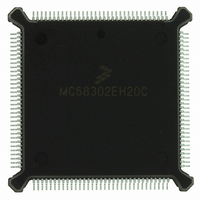MC68302EH20C Freescale Semiconductor, MC68302EH20C Datasheet - Page 223

MC68302EH20C
Manufacturer Part Number
MC68302EH20C
Description
IC MPU MULTI-PROTOCOL 132-PQFP
Manufacturer
Freescale Semiconductor
Datasheets
1.MC68302AG20C.pdf
(4 pages)
2.MC68302AG20C.pdf
(2 pages)
3.MC68302AG20C.pdf
(13 pages)
4.MC68302EH20C.pdf
(481 pages)
Specifications of MC68302EH20C
Processor Type
M683xx 32-Bit
Speed
20MHz
Voltage
5V
Mounting Type
Surface Mount
Package / Case
132-MQFP, 132-PQFP
Family Name
M68000
Device Core
ColdFire
Device Core Size
32b
Frequency (max)
20MHz
Instruction Set Architecture
RISC
Supply Voltage 1 (typ)
5V
Operating Temp Range
0C to 70C
Operating Temperature Classification
Commercial
Mounting
Surface Mount
Pin Count
132
Package Type
PQFP
Lead Free Status / RoHS Status
Lead free / RoHS Compliant
Features
-
Lead Free Status / Rohs Status
Compliant
Available stocks
Company
Part Number
Manufacturer
Quantity
Price
Company:
Part Number:
MC68302EH20C
Manufacturer:
Freescale Semiconductor
Quantity:
10 000
Part Number:
MC68302EH20C
Manufacturer:
FREESCALE
Quantity:
20 000
Company:
Part Number:
MC68302EH20CB1
Manufacturer:
Freescale Semiconductor
Quantity:
10 000
Company:
Part Number:
MC68302EH20CR2
Manufacturer:
Freescale Semiconductor
Quantity:
10 000
- MC68302AG20C PDF datasheet
- MC68302AG20C PDF datasheet #2
- MC68302AG20C PDF datasheet #3
- MC68302EH20C PDF datasheet #4
- Current page: 223 of 481
- Download datasheet (2Mb)
Communications Processor (CP)
begins. However, if a character is not SOH, ENQ, DLE, or SYNC, hunt mode is again en-
tered. On asynchronous links, byte synchronization is achieved by the start/stop protocol of
the UART. The DDCMP controller is now byte-synchronized and performs SYN1–SYN2
stripping, until receiving one of the three user-defined special starting bytes (SOH for data
messages, ENQ for control messages, and DLE for maintenance messages).
If a match is detected, the DDCMP controller fetches the next BD and, if it is empty, starts
to transfer the incoming header to the BD's associated data buffer. The DDCMP controller
counts the bytes of the fixed-length header and compares the received header address field
to the four user-defined values after masking the result with the address mask. When a
match is detected, the DDCMP controller continues to transfer the incoming message to the
data buffer. The header CRC field (CRC1) is checked and is written to the data buffer. The
DDCMP controller updates the CRC error (CR) bit, sets the header (H) bit, writes the mes-
sage type and status bits into the BD, and clears the empty bit. It next generates a maskable
receive block interrupt (RBK), indicating that a header has been received and is in memory.
If the header was a control message, the DDCMP controller waits for a new message.
If there is no match in address comparison and the header is error free, the DDCMP con-
troller will use the same buffer for the next message. To maintain synchronization, the DDC-
MP controller counts the data length based on the count field contained in the header.
When the data buffer has been filled, the DDCMP controller clears the empty bit in the BD
and generates a maskable received buffer interrupt (RBD). If the incoming message ex-
ceeds the length of the data buffer, the DDCMP controller fetches the next BD in the table,
and, if it is empty, continues to transfer the rest of the message to the new data buffer. When
the message ends, the CRC2 field is checked and written to the data buffer. The DDCMP
controller sets the last bit, writes the message type and other status bits into the BD, and
clears the empty bit. Following this, it generates an RBK, indicating that a message has
been received and is in memory. The DDCMP controller then waits for a new message.
4.5.14.3 DDCMP Memory Map
When configured to operate in DDCMP mode, the IMP overlays the structure illustrated in
Table 4-9 onto the protocol-specific area of that SCC's parameter RAM. Refer to 2.8
MC68302 Memory Map for the placement of the three SCC parameter RAM areas and to
Table 4-5 for the other parameter RAM values.
MOTOROLA
MC68302 USER’S MANUAL
4-103
Related parts for MC68302EH20C
Image
Part Number
Description
Manufacturer
Datasheet
Request
R
Part Number:
Description:
Manufacturer:
Freescale Semiconductor, Inc
Datasheet:

Part Number:
Description:
MC68302 Configuring the Chip Selects on the MC68302
Manufacturer:
Motorola / Freescale Semiconductor

Part Number:
Description:
MC68302 Design Concept - Expanding Interrupts on the MC68302
Manufacturer:
Motorola / Freescale Semiconductor

Part Number:
Description:
MC68302 MC68302 Adapting a WAN Controller to a LAN Environment
Manufacturer:
Motorola / Freescale Semiconductor

Part Number:
Description:
MC68302 EKB Applications - Power Measurements on the MC68302
Manufacturer:
Motorola / Freescale Semiconductor

Part Number:
Description:
MC68302 Interfacing the MC68020 to a Slave MC68302
Manufacturer:
Motorola / Freescale Semiconductor

Part Number:
Description:
MC68302 MC68302 Software Performance
Manufacturer:
Motorola / Freescale Semiconductor

Part Number:
Description:
MC68302 Evaluating EDX on the ADS302
Manufacturer:
Motorola / Freescale Semiconductor

Part Number:
Description:
MC68302 Design Advisory #1 - MC68SC302 Passive ISDN Protocol Engine
Manufacturer:
Motorola / Freescale Semiconductor

Part Number:
Description:
MC68302, MC68360, and MPC860 Characteristics and Design Notes for Crystal Feedback Oscillators
Manufacturer:
Motorola / Freescale Semiconductor
Part Number:
Description:
Mc68302 Integrated Multi-protocol Processor
Manufacturer:
Freescale Semiconductor, Inc
Datasheet:
Part Number:
Description:
Manufacturer:
Freescale Semiconductor, Inc
Datasheet:
Part Number:
Description:
Manufacturer:
Freescale Semiconductor, Inc
Datasheet:
Part Number:
Description:
Manufacturer:
Freescale Semiconductor, Inc
Datasheet:
Part Number:
Description:
Manufacturer:
Freescale Semiconductor, Inc
Datasheet:











